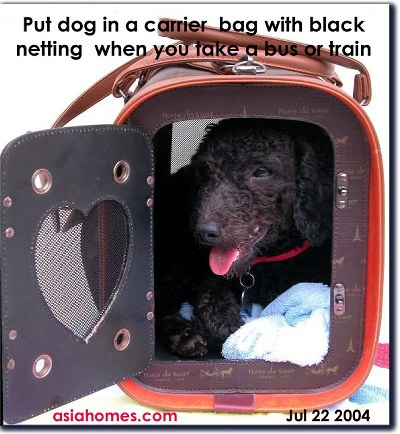|
Personal Experiences - Dog
Training
The
Separation-Anxiety Dog
Joanne
Chong
I used to have the impression that dogs could be left
alone when I go to work.
Thus when Cotton (Poodle/Shitzu) barked excessively
and destroyed the furniture when he was alone, I deduced that
he needed obedience training as I did not know there was a dog
behavioural problem known as separation anxiety.
Coming home was a chore. His toilet (newspapers with his
waste) would be torn and well distributed all over the house.
He would stink as he dirtied himself. It was not those
happy-dog-welcoming-owner moments that most owners told us or
seen in doggy advertisements.
When we disciplined his "wild and retaliating"
behaviour using isolation, caging and even caning, I always
felt sad and sorry for him. A strong sense of
disappointment, that my husband and I were not good owners would always dampen
our spirits in the evening when we reached home after a hard
day's work. There were also thoughts of
giving him up.

Cotton felt secure inside his carrier cage, the day
after neutering. He was panting so much that his
rectal temperature rose above 39.8 degrees when he
arrived at the veterinary surgery. He was suffering from
separation anxiety rather than from a high fever from
infections. The rapid and continuous panting
resulted in a reddish tongue due to a high body
temperature. He was operated and did not suffer any side
effects. |
From a large source of information in magazines,
books and the internet, I
learnt that Cotton's unsociable behaviour were symptoms of
Separation Anxiety. If the signs you are experiencing are
similar to what I have explained above, here are some
suggestions:
1. Physical punishment
may worsen the problem. Your pet may be yearning for your
attention the whole day. Although the punishment may have
inflicted pain, it may not associate it as a consequence to
destroying the furnishings. In fact, it may not mind it
as it received attention when you beat or shout at it immediately upon your return.
2. Leave the lights
and radio on while you are away. Also, let him play
with lots of toys, including
chew toys.
3. Pay a kid in your
neighbourhood $20 weekly (or more if he feeds and change the
newspapers)
for taking your pet out for a walk in the middle of the day.
This breaks the isolation to a few parts of the day and
reduce the trauma of separation.
4. Castration or spay.
It's socially responsible too. Castration/spaying depletes
sex hormones that will in  turn
reduce the aggressive or territorial behaviour. Other
effects may manifest straight after the surgery, namely, reduced
odour of urine in the male dog and unsociable behaviour like
mounting onto legs of visitors. turn
reduce the aggressive or territorial behaviour. Other
effects may manifest straight after the surgery, namely, reduced
odour of urine in the male dog and unsociable behaviour like
mounting onto legs of visitors.
5. Nothing should
discount the need for obedience training especially in hyper-active
dogs.
Your pets want to give their best to you, as much as you do.
The fact that we speak different languages can be a
deterrent to a potentially strong connectivity. Seek
professional help from dog trainers or others. Remember, you are never alone.
Further
information.
1. How was Cotton toilet/house-trained?
House breaking with a cage (four pieces of fencing joined at
sides, without top and bottom) on newspapers. He was
confined to the cage for 2 weeks. In that time, he could
roam around the house only under close supervision.
Whenever, he defacated or urinated on "non-designated"
spots, I picked up the waste with a piece of toilet paper, place
it on the newspapers together with him to watch this transfer.
I then pushed his head to the newspapers next to the
soiled toilet paper and say "Here!" in a loud and
punitive voice tone.
For repeated offences, I used rolled up newspapers to hit him on
his bottom. I know this procedure is not highly
recommended but it may be applicable to some hyperactive dogs.
2. How does Cotton cope when I go to work? Is he
confined to one bedroom?
I took him with me wherever I went 3 weeks after I bought him.
Subsequently, I would leave him at home with my mother-in-law.
No, he is not confined to one bedroom but allowed to roam
around the apartment.
Readers who
wish to share their experiences in how to handle a
separation-anxiety dog, please email your information to judy@sinpets.com.

This educational article is extracted from the book, "How
Your Puppy Can Live Longer". It
is sponsored by asiahomes.com,
"affordable homes for expatriates for Sin Pets No. 2, Sep -
Dec 2004".
Pictures are © toapayohvets.com.
Last updated: 25 Jul 2004
|


